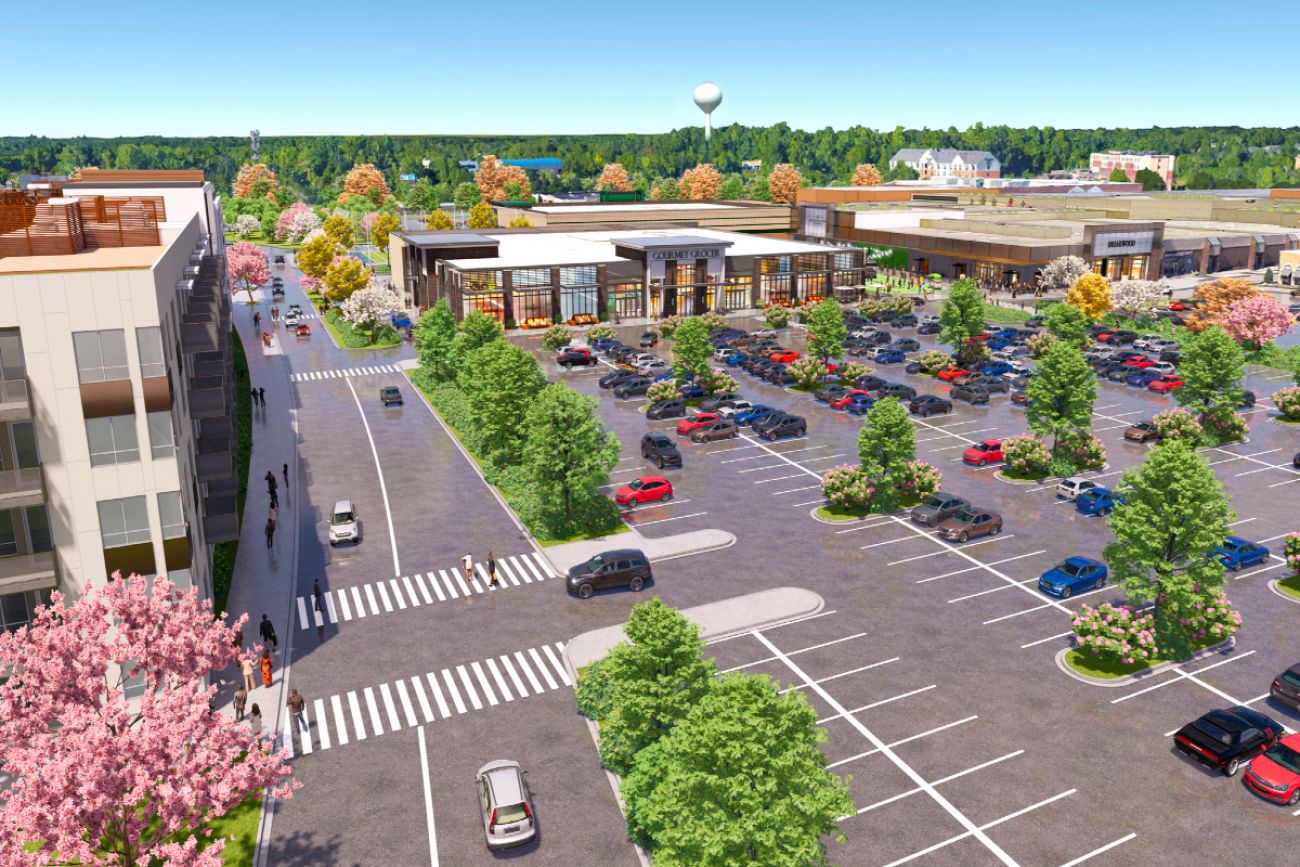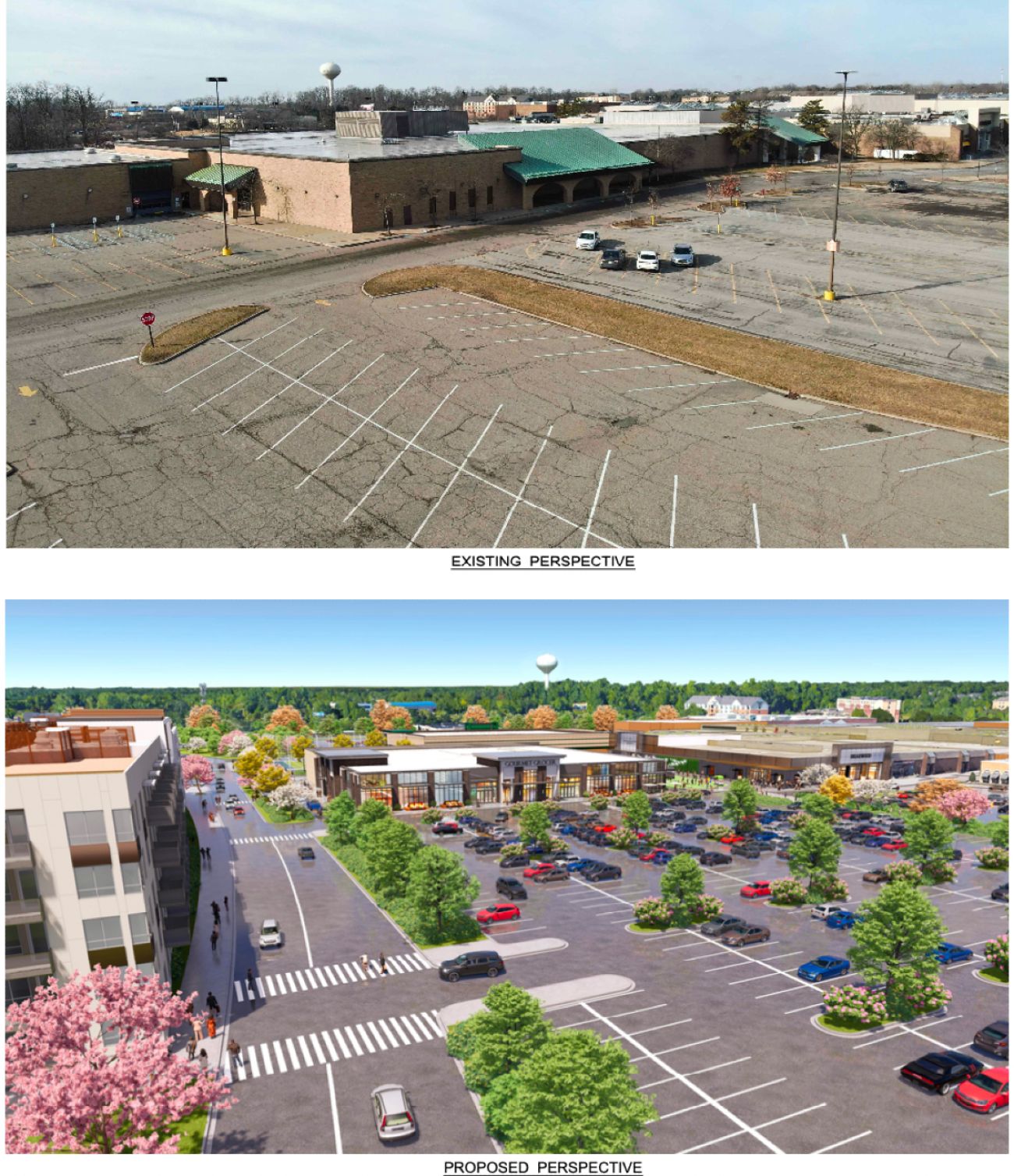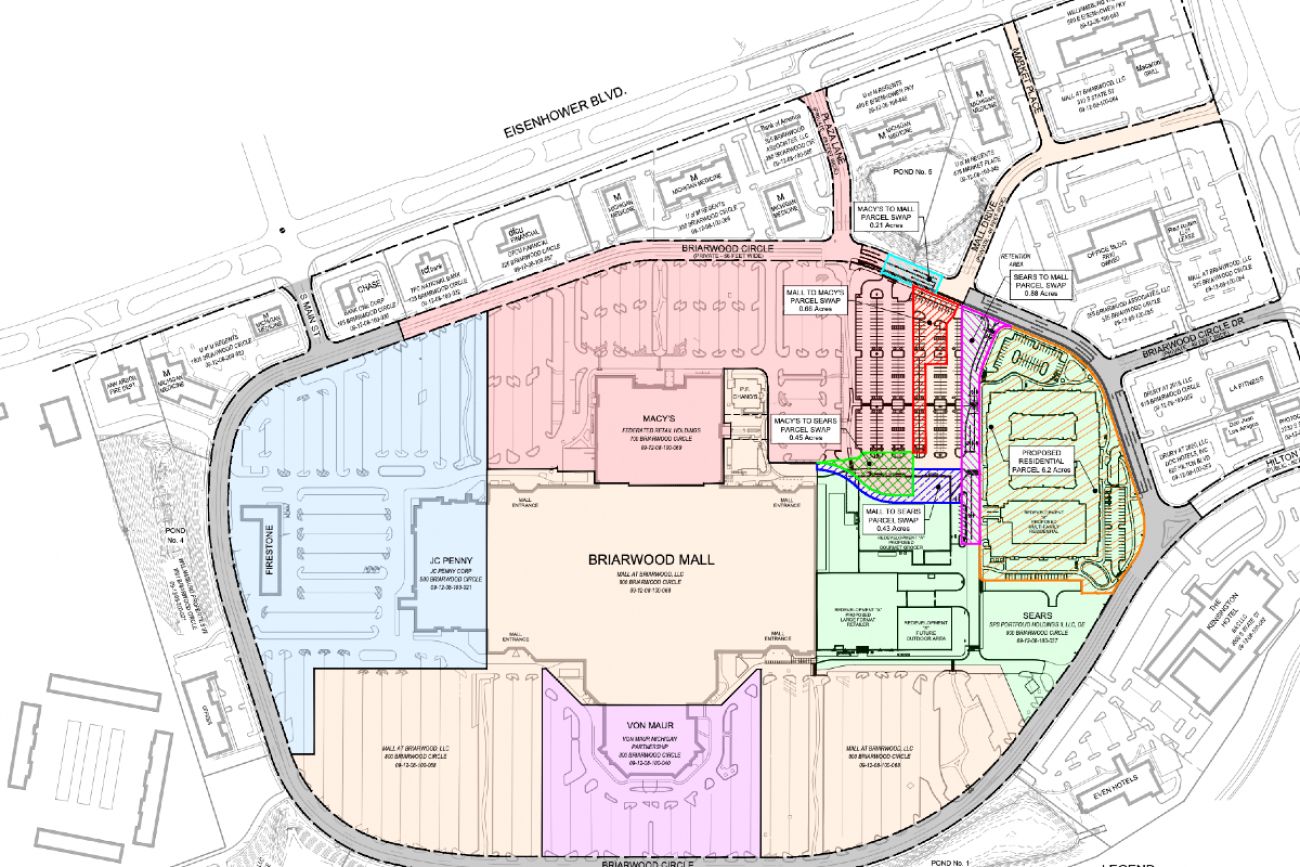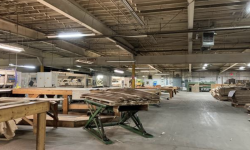A Sears comes down, apartments go up at Michigan mall. Is this the future?

- The largest U.S. mall owner is teaming with a developer to create village-style development at Briarwood Mall in Ann Arbor
- The plan to add density to the mall is unique in Michigan and newer for top-tier malls across the U.S.
- While shopping patterns have changed, the state’s best malls are part of a resurgence in the properties
ANN ARBOR — A closed department store surrounded by rays of faded parking-striped concrete can inspire redevelopment dreams anywhere in the United States.
“Malls are dying,” some say. “Scrape it to the pavement and start over,” others might advise.
Simon Property Group, the largest mall owner in the U.S., this spring announced a new option: A $1.5 billion five-year plan to add density and new uses to its mall properties, starting largely with California and the northwest U.S.
Also making the early list: Briarwood Mall in Ann Arbor.
With the move, the 50-year-old Michigan shopping center joins some of the best malls in the country — and there are a number of them, where occupancy pushes 100 percent and the sales per square foot, a recent study found, beats other types of retail space. There, the dreams are getting bigger.
In these properties, the choice isn't to bring new types of businesses into empty stores or demolish and rebuild. Instead, the most ambitious question is how to turn the existing mall into a village environment, with housing, sidewalks, green spaces and maybe even a swimming pool right on the same property, within steps of the mall’s stores and services targeting both regional shoppers and nearby residents.
Plans approved in late 2023 will launch the mall re-envisioning in Ann Arbor in 2024, fueled by a partnership between Simon [NYSE:SPG], Briarwood’s owner; and Hines, a $95 billion private global real estate investment company targeting malls for its next wave of investment.
“This really is the future of malls,” said Jeff Hauptman, CEO of the Oxford Companies, which owns and manages 2.7 million square feet of commercial property, much of it near Briarwood in the South State Street corridor of Ann Arbor.

With the Briarwood shopping center transformation into a more balanced neighborhood, “we’re seeing it take place right in front of our eyes in Michigan,” he said.
The plan at Briarwood is to demolish the 166,000 square foot Sears store, which Simon acquired for $2.2 million in 2022, three years after the anchor store closed. The closing left a “dead zone” at the busy mall, which also has Von Maur, Macy’s and JC Penney as anchors, combining with other stores and restaurants into about 1 million square feet of retail space.
Using the Sears footprint and surrounding parking spaces, the developers will add two new two-story retail spaces — a 58,000 square-foot grocery and 100,000 square foot sporting goods store, neither of which have been announced – along with 370 apartments in two four-story buildings that also will include parking.
Sidewalks, bicycle parking spaces and a half-acre outdoor plaza will unify the housing and the retail space, while connecting both to the surrounding mall area, which is rimmed by offices, hotels and chain restaurants.

More broadly, the area is an I-94 gateway to Ann Arbor, the fifth largest city in the state, home to the growing University of Michigan and one of the few cities attracting more residents than it loses.
City officials want to add more housing, said Brett Lenart, manager of Ann Arbor’s planning department, particularly in key commercial corridors that could absorb more building density and offer nearby shopping and work options.
Talks with Simon over the past couple of years yielded the plan for Briarwood, Lenart said, and over 2023 the plans passed planning reviews and in December gained unanimous City Council approval.
“Malls across the country are starting to think more creatively about retail and what services they can incorporate,” Lenart said.
Adding housing also adds to the options for the malls, he added, pointing to the grocery store planned for Briarwood.
“This was pretty exciting to see Simon putting the first stake in the ground to say we could really expand what the mall has been used for historically (but) in a bigger-use way,” Lenart said.
Malls and businesses
While Briarwood is smaller than some of the malls targeted for the Simon’s mall intensification, building the new housing there is a good fit for Hines, said Brad Soderwell, managing director of new business development in Midwest markets for the Houston-based investment company.
“We really love the location,” Soderwell said, describing the housing demand in Ann Arbor and the opportunity to build it with retail and services “right at your doorstep.”
U.S. malls over the last decade saw a decline in shopper traffic and waves of retailer changes like bankruptcies and store closings, but in 2022 saw more store openings than closures for the first time since 2016. Also that year, mall sales grew more than 11 percent to nearly $819 billion, according to Coresight Research.
Related:
Ann Arbor wants more housing and fewer cars. Is 'unzoning' the answer?
Turning Ann Arbor into Austin and other tech recommendations for Michigan
A Michigan mall’s transformation: From Macy’s to self-storage
U-M, MSU thrive while Michigan regional universities scramble for students
But not all malls are among the success stories: Top-tier malls in locations with higher area incomes are still making sales and attracting retailers, along with other types of businesses — Briarwood, for example, has two driving schools — while lower-end properties face more store closures and upended financials for owners.
Michigan lags behind the rest of the country in mall redevelopments, said Luke Bonner, CEO of Bonner Advisory Group in Ann Arbor.
“With a lack of population and income growth for most Michigan communities, there is not enough demand for substantial redevelopment projects,” Bonner told Bridge Michigan.
Plans for mall viability often include adding housing or standalone restaurants in parking lots, or simply demolishing and starting over with a new design. Malls also have become better at adding services and experiences, including arcades and offices.
The paybacks can be slow as customers are lured back to the slower shopping centers. And the largest projects in the state, in many cases, are still taking shape:
- Northland Mall in Southfield was demolished, except for the former J.L. Hudson’s store, which anchored the first regional mall in the U.S. Construction for the first of at least 1,500 new apartments is underway on the 159-acre site.
- Lakeside Mall, the three-story 1970s shopping showcase in Sterling Heights, is still open but its owners expect to turn it into a 110-acre city center, with housing, offices and retail space. Demolition may take place in late 2024.
- Other properties also went through a “de-malling,” like Westshore Mall in Holland, which was converted into an outdoor shopping plaza, much like Ann Arbor’s Arborland two decades ago — a move that made that tired mall into a regional destination.
But still more remain in varying stages, ranging from still functioning as a shopping center — like Twelve Oaks in Novi and Somerset in Troy, two still-popular destinations — to properties that only invite redevelopment fantasies, like Westland Mall, where the city considered buying it as a move to upgrade the site.
Mall redevelopments are expensive and complicated due to the tenants in place and multiple owners at most malls, Bonner said.
“With a few exceptions, Michigan isn’t bursting at the seams with new incomes and demand for goods, services and housing,” Bonner said. “Most malls require a significant amount of density to make numbers work; without strong demand, these malls will take a very long time to turn over.”
Yet Simon malls — including Twelve Oaks, which it runs for Bloomfield Hills-based subsidiary Taubman — experienced a record leasing year, CFO Brian McDade told analysts on a conference call last fall. Its outlets, including Birch Run Premium Outlets near Frankenmuth and Great Lakes Crossing in Auburn Hills, also are performing well, CFO Brian McDade told analysts on a conference call last fall.
As the company looks ahead, “one of the biggest growth vectors of the company over the next decade is the recapture of department store(s),” McDade said. “More importantly, the land underneath it to create a better higher use for that real estate.
Reimagining the mall
The South State portion of Ann Arbor is close to I-94, but without housing, the area is more of a “flyover” to offices and stores before people head elsewhere, Oxford’s Hauptman said.
Ahead of Briarwood’s changes, the city approved an area-wide zoning plan to encourage more building and housing. Turning the office-dense corridor into a neighborhood will cultivate more activity around-the-clock and make use of underutilized parking, Hauptman said.
Oxford, in fact, just submitted its own plan to develop the corridor, seeking to add 1,200 condominium units and apartments plus more retail to 20 acres around the landmark 777 Building at State and Eisenhower, which is within walking distance of Briarwood.
Hines’ investment at Briarwood will be about $100 million, Soderwell said. Apartment leasing should begin by 2026, he added.
One distinguishing feature of the Ann Arbor mall invigoration is the financial ability of Simon and Hines to do the project, since “capital markets are tough and interest rates are high,” Soderwell said.
For a developer, “you have to be selective.”
Business Watch
Covering the intersection of business and policy, and informing Michigan employers and workers on the long road back from coronavirus.
- About Business Watch
- Subscribe
- Share tips and questions with Bridge Business Editor Paula Gardner
Thanks to our Business Watch sponsors.
Support Bridge's nonprofit civic journalism. Donate today.
See what new members are saying about why they donated to Bridge Michigan:
- “In order for this information to be accurate and unbiased it must be underwritten by its readers, not by special interests.” - Larry S.
- “Not many other media sources report on the topics Bridge does.” - Susan B.
- “Your journalism is outstanding and rare these days.” - Mark S.
If you want to ensure the future of nonpartisan, nonprofit Michigan journalism, please become a member today. You, too, will be asked why you donated and maybe we'll feature your quote next time!




